
Chapter 16 Rent, Interest, and Profit Answer Key
Multiple Choice Questions
1.
Economic or pure rent is:
AACSB: Analytic
Accessibility: Keyboard Navigation
Blooms: Remember
Difficulty: 1 Easy
Learning Objective: 16-01 Explain the nature of economic rent and how it is determined.
Topic: Economic rent
2.
To say that land rent performs no incentive function means that:
AACSB: Analytic
Accessibility: Keyboard Navigation
Blooms: Remember
Difficulty: 1 Easy
Learning Objective: 16-01 Explain the nature of economic rent and how it is determined.
Topic: Economic rent

3.
Which of the following statements is
correct
?
AACSB: Analytic
Accessibility: Keyboard Navigation
Blooms: Remember
Difficulty: 1 Easy
Learning Objective: 16-01 Explain the nature of economic rent and how it is determined.
Topic: Economic rent
4.
Economic rent refers to the price paid for land and other natural resources that:
AACSB: Analytic
Accessibility: Keyboard Navigation
Blooms: Remember
Difficulty: 1 Easy
Learning Objective: 16-01 Explain the nature of economic rent and how it is determined.
Topic: Economic rent
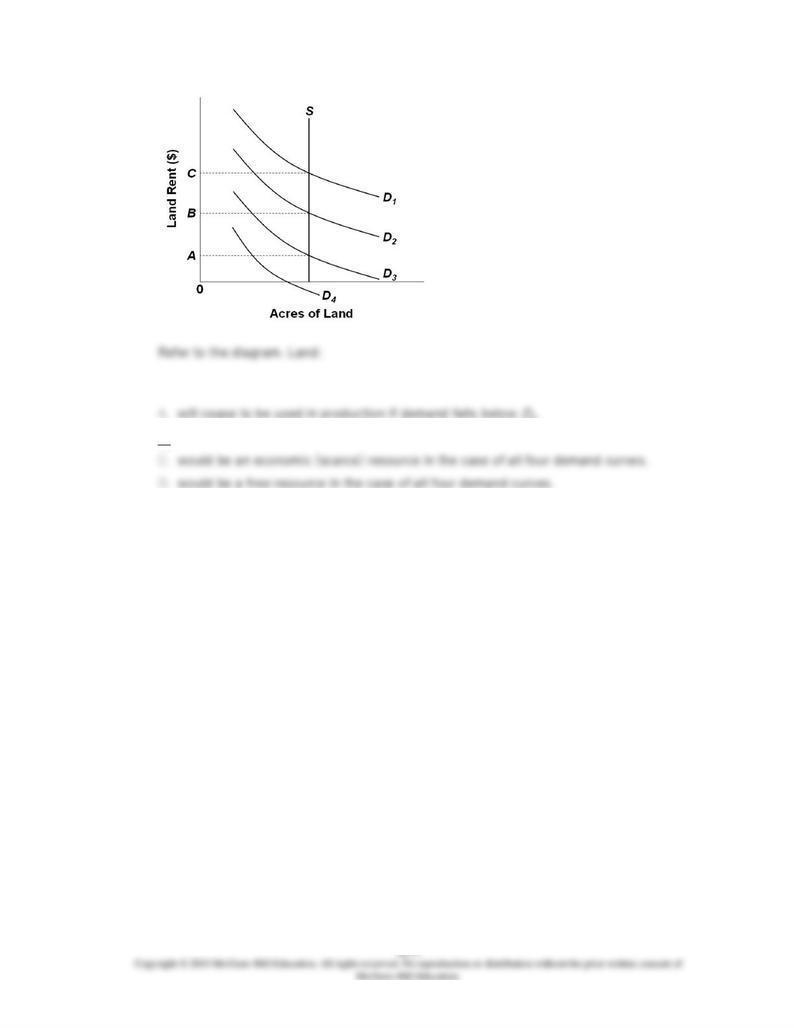
5.
4.
B.
would be a free resource if demand is
D
4 or less.
AACSB: Reflective Thinking
Blooms: Apply
Difficulty: 2 Medium
Learning Objective: 16-01 Explain the nature of economic rent and how it is determined.
Topic: Economic rent
Type: Graph
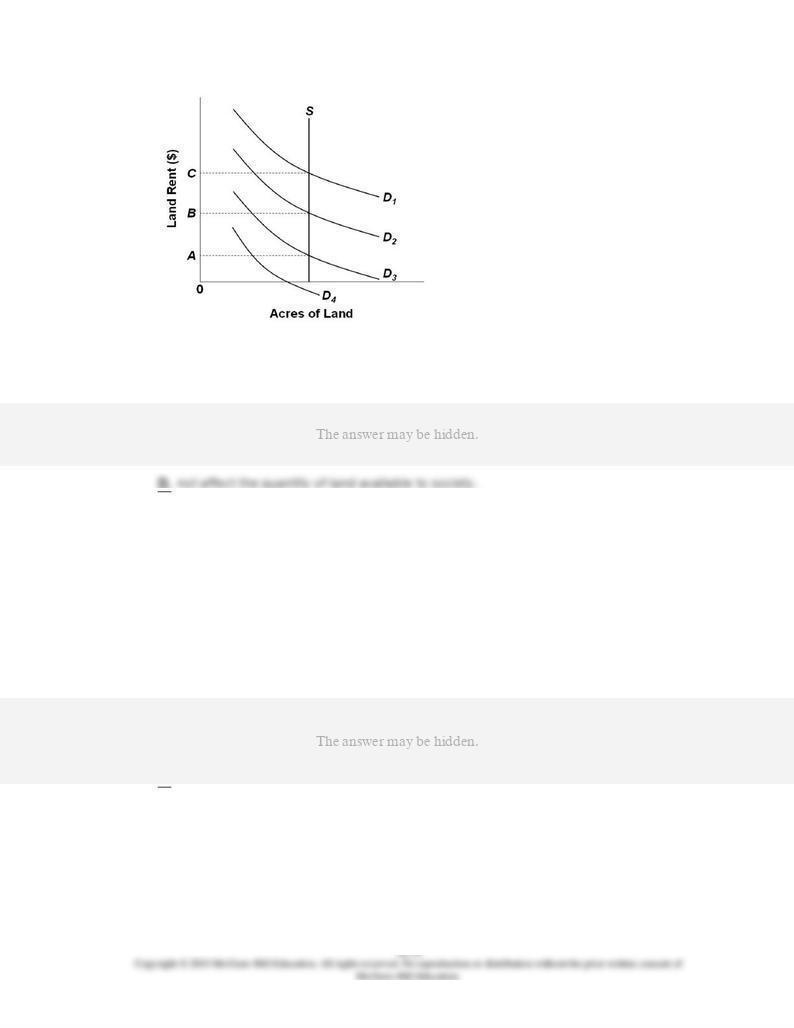
6.
Refer to the diagram. If demand is
D
2, a tax of
X
per acre will:
3 or
4.
AACSB: Reflective Thinking
Blooms: Analyze
Difficulty: 3 Hard
Learning Objective: 16-01 Explain the nature of economic rent and how it is determined.
Topic: Economic rent
Type: Graph
7.
Landowners will not receive any rent so long as:
AACSB: Reflective Thinking
Accessibility: Keyboard Navigation
Blooms: Analyze
Difficulty: 3 Hard
Learning Objective: 16-01 Explain the nature of economic rent and how it is determined.
Topic: Economic rent

8.
The incentive function of prices:
AACSB: Analytic
Accessibility: Keyboard Navigation
Blooms: Remember
Difficulty: 1 Easy
Learning Objective: 16-01 Explain the nature of economic rent and how it is determined.
Topic: Economic rent
9.
The demand for farmland will increase if:
AACSB: Reflective Thinking
Accessibility: Keyboard Navigation
Blooms: Analyze
Difficulty: 3 Hard
Learning Objective: 16-01 Explain the nature of economic rent and how it is determined.
Topic: Economic rent
10.
For all practical purposes, the supply of land is:
AACSB: Reflective Thinking
Accessibility: Keyboard Navigation
Blooms: Remember
Difficulty: 1 Easy

Learning Objective: 16-01 Explain the nature of economic rent and how it is determined.
Topic: Economic rent
11.
Which of the following is
correct
?
AACSB: Reflective Thinking
Accessibility: Keyboard Navigation
Blooms: Understand
Difficulty: 2 Medium
Learning Objective: 16-01 Explain the nature of economic rent and how it is determined.
Topic: Economic rent
12.
The total supply of land is:
AACSB: Reflective Thinking
Accessibility: Keyboard Navigation
Blooms: Understand
Difficulty: 2 Medium
Learning Objective: 16-01 Explain the nature of economic rent and how it is determined.
Topic: Economic rent

13.
The rent paid for the pasture land used to graze cattle would increase if:
AACSB: Reflective Thinking
Accessibility: Keyboard Navigation
Blooms: Analyze
Difficulty: 3 Hard
Learning Objective: 16-01 Explain the nature of economic rent and how it is determined.
Topic: Economic rent
14.
Refer to the diagrams. Assume that only wheat can be grown on the three grades of land
shown in Figures (a), (b), and (c). Also assume that identical amounts of labor, capital,
and other needed inputs are used in farming each grade of land. On the basis of these
three figures, we:
AACSB: Reflective Thinking
Blooms: Analyze
Difficulty: 3 Hard
Learning Objective: 16-01 Explain the nature of economic rent and how it is determined.

Topic: Economic rent
Type: Graph
15.
Refer to the diagrams. Assume that only wheat can be grown on the three grades of land
shown in Figures (a), (b), and (c). Also assume that identical amounts of labor, capital,
and other needed inputs are used in farming each grade of land. On the basis of these
three figures, we can say that:
A.
the land shown in both Figures (a) and (b) is a "free good."
AACSB: Reflective Thinking
Blooms: Apply
Difficulty: 2 Medium
Learning Objective: 16-01 Explain the nature of economic rent and how it is determined.
Topic: Economic rent
Type: Graph
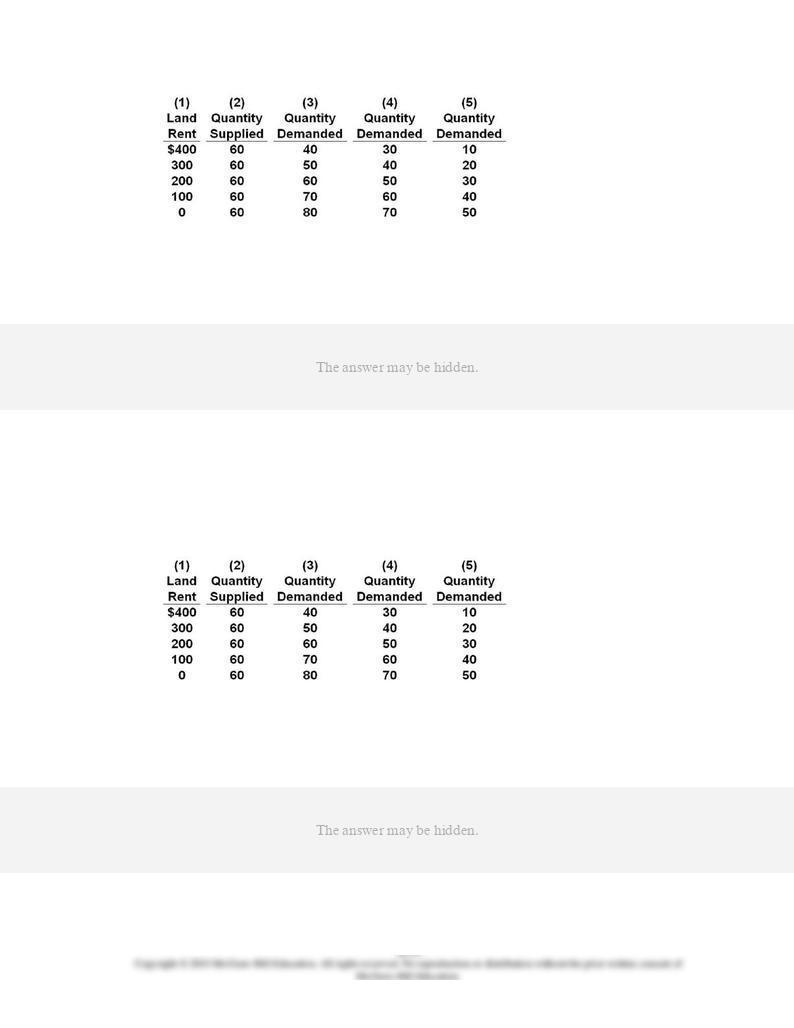
16.
Refer to the table, in which the values for columns (2) through (5) are in acres. If the
relevant columns are (1), (2), and (3), land rent will be:
AACSB: Analytic
Blooms: Analyze
Difficulty: 3 Hard
Learning Objective: 16-01 Explain the nature of economic rent and how it is determined.
Topic: Economic rent
Type: Table
17.
Refer to the table, in which the values for columns (2) through (5) are in acres. If the
relevant columns are (1), (2), and (4), land rent will be:
AACSB: Analytic
Blooms: Analyze
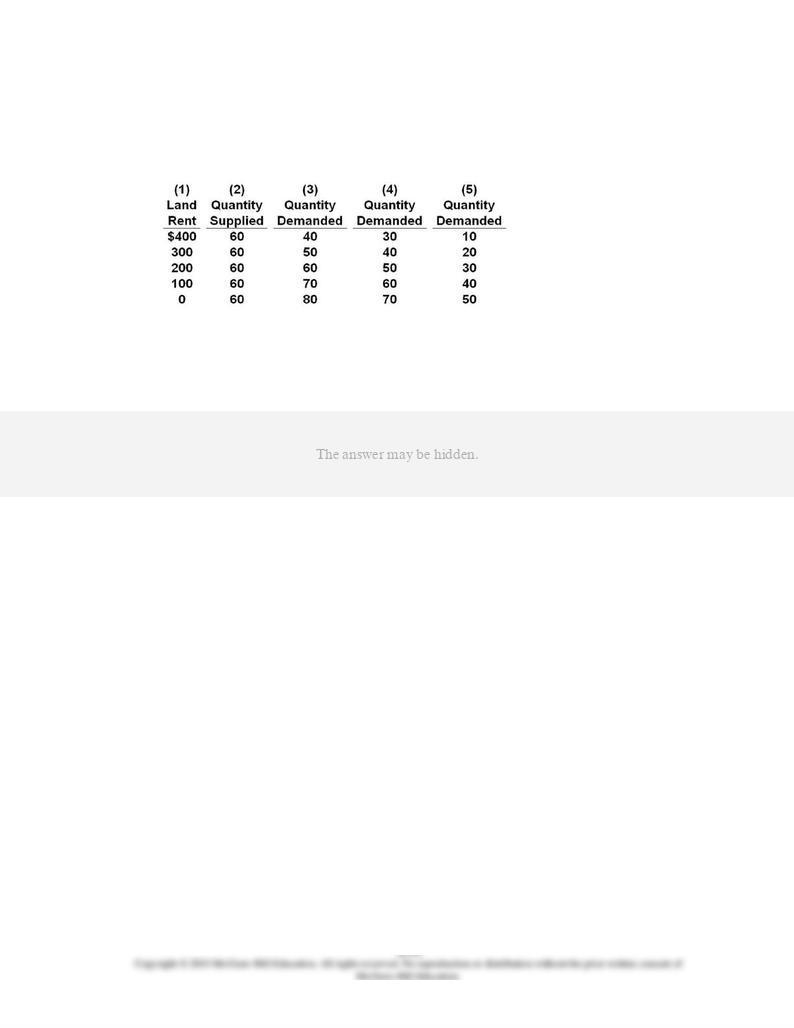
Difficulty: 3 Hard
Learning Objective: 16-01 Explain the nature of economic rent and how it is determined.
Topic: Economic rent
Type: Table
18.
Refer to the table, in which the values for columns (2) through (5) are in acres. If the
relevant columns are (1), (2), and (5), land rent will be:
AACSB: Analytic
Blooms: Analyze
Difficulty: 3 Hard
Learning Objective: 16-01 Explain the nature of economic rent and how it is determined.
Topic: Economic rent
Type: Table

19.
Refer to the table, in which the values for columns (2) through (5) are in acres. Positive
land rent will occur if the relevant columns are:
AACSB: Analytic
Blooms: Analyze
Difficulty: 3 Hard
Learning Objective: 16-01 Explain the nature of economic rent and how it is determined.
Topic: Economic rent
Type: Table
20.
The demand for land is:
AACSB: Analytic
Accessibility: Keyboard Navigation
Blooms: Remember
Difficulty: 1 Easy
Learning Objective: 16-01 Explain the nature of economic rent and how it is determined.
Topic: Economic rent

21.
The marginal revenue product (MRP) of land declines as more land is brought into use. As
a result the:
AACSB: Reflective Thinking
Accessibility: Keyboard Navigation
Blooms: Understand
Difficulty: 2 Medium
Learning Objective: 16-01 Explain the nature of economic rent and how it is determined.
Topic: Economic rent
22.
The marginal revenue product (MRP) of land declines as more land is brought into
production because:
AACSB: Reflective Thinking
Accessibility: Keyboard Navigation
Blooms: Understand
Difficulty: 2 Medium
Learning Objective: 16-01 Explain the nature of economic rent and how it is determined.
Topic: Economic rent
23.
The economist who advocated a single tax on land was:
AACSB: Reflective Thinking

Accessibility: Keyboard Navigation
Blooms: Remember
Difficulty: 1 Easy
Learning Objective: 16-01 Explain the nature of economic rent and how it is determined.
Topic: Economic rent: land taxation
24.
A unique characteristic of taxes on economic rents is that such taxes:
AACSB: Reflective Thinking
Accessibility: Keyboard Navigation
Blooms: Understand
Difficulty: 2 Medium
Learning Objective: 16-01 Explain the nature of economic rent and how it is determined.
Topic: Economic rent: land taxation
25.
Henry George's single-tax movement was based on the argument that:
AACSB: Reflective Thinking
Accessibility: Keyboard Navigation
Blooms: Understand
Difficulty: 2 Medium
Learning Objective: 16-01 Explain the nature of economic rent and how it is determined.
Topic: Economic rent: land taxation

26.
In his book
Progress
and
Poverty
, Henry George argued that:
AACSB: Reflective Thinking
Accessibility: Keyboard Navigation
Blooms: Remember
Difficulty: 1 Easy
Learning Objective: 16-01 Explain the nature of economic rent and how it is determined.
Topic: Economic rent: land taxation
27.
Henry George advocated a single tax on:
AACSB: Reflective Thinking
Accessibility: Keyboard Navigation
Blooms: Remember
Difficulty: 1 Easy
Learning Objective: 16-01 Explain the nature of economic rent and how it is determined.
Topic: Economic rent: land taxation

28.
Some economists advocate taxes on land because such taxes:
AACSB: Reflective Thinking
Accessibility: Keyboard Navigation
Blooms: Understand
Difficulty: 2 Medium
Learning Objective: 16-01 Explain the nature of economic rent and how it is determined.
Topic: Economic rent: land taxation
29.
Critics of a single tax on land oppose the idea because:
AACSB: Reflective Thinking
Accessibility: Keyboard Navigation
Blooms: Understand
Difficulty: 2 Medium
Learning Objective: 16-01 Explain the nature of economic rent and how it is determined.
Topic: Economic rent: land taxation
30.
Interest is the:
AACSB: Analytic

Accessibility: Keyboard Navigation
Blooms: Remember
Difficulty: 1 Easy
Learning Objective: 16-02 Define interest and explain how interest rates vary based on risk; maturity; loan size; and
taxability.
Topic: Interest
31.
Suppose a person pays $80 of annual interest on a loan that has a 5 percent annual
interest rate. The loan amount is:
AACSB: Analytic
Accessibility: Keyboard Navigation
Blooms: Apply
Difficulty: 2 Medium
Learning Objective: 16-02 Define interest and explain how interest rates vary based on risk; maturity; loan size; and
taxability.
Topic: Interest
32.
Suppose that interest payments are $140 per year on a $1,000 loan and $1,188 per year on
an $8,485 loan. The interest rates on the two loans are:
C.
18.8 percent on both loans.
D.
1.4 percent and 11.8 percent, respectively.
AACSB: Analytic
Accessibility: Keyboard Navigation
Blooms: Apply
Difficulty: 2 Medium
Learning Objective: 16-02 Define interest and explain how interest rates vary based on risk; maturity; loan size; and
taxability.
Topic: Interest

33.
Which of the following is
correct
?
AACSB: Analytic
Accessibility: Keyboard Navigation
Blooms: Understand
Difficulty: 2 Medium
Learning Objective: 16-02 Define interest and explain how interest rates vary based on risk; maturity; loan size; and
taxability.
Topic: Interest
34.
The equilibrium interest rate equates:
AACSB: Reflective Thinking
Accessibility: Keyboard Navigation
Blooms: Understand
Difficulty: 2 Medium
Learning Objective: 16-03 Explain the loanable funds theory of interest rates.
Topic: Loanable funds theory of interest rates

35.
The supply curve of loanable funds is upsloping because:
AACSB: Reflective Thinking
Accessibility: Keyboard Navigation
Blooms: Understand
Difficulty: 2 Medium
Learning Objective: 16-03 Explain the loanable funds theory of interest rates.
Topic: Loanable funds theory of interest rates
36.
The fact that people prefer present consumption to future consumption results in:
AACSB: Reflective Thinking
Accessibility: Keyboard Navigation
Blooms: Understand
Difficulty: 2 Medium
Learning Objective: 16-03 Explain the loanable funds theory of interest rates.
Topic: Loanable funds theory of interest rates
37.
Which of the following is
not
a source of loanable funds?
AACSB: Analytic

Accessibility: Keyboard Navigation
Blooms: Remember
Difficulty: 1 Easy
Learning Objective: 16-03 Explain the loanable funds theory of interest rates.
Topic: Loanable funds theory of interest rates
38.
Which of the following is
not
a component of the demand for loanable funds?
AACSB: Analytic
Accessibility: Keyboard Navigation
Blooms: Remember
Difficulty: 1 Easy
Learning Objective: 16-03 Explain the loanable funds theory of interest rates.
Topic: Loanable funds theory of interest rates
39.
The demand for loanable funds is downsloping:
AACSB: Reflective Thinking
Accessibility: Keyboard Navigation
Blooms: Understand
Difficulty: 2 Medium
Learning Objective: 16-03 Explain the loanable funds theory of interest rates.
Topic: Loanable funds theory of interest rates

40.
Other things equal, an increase in the productivity of capital goods will:
AACSB: Reflective Thinking
Accessibility: Keyboard Navigation
Blooms: Analyze
Difficulty: 3 Hard
Learning Objective: 16-03 Explain the loanable funds theory of interest rates.
Topic: Loanable funds theory of interest rates
41.
If Congress were to pass a law exempting interest on saving from taxation, the:
AACSB: Reflective Thinking
Accessibility: Keyboard Navigation
Blooms: Analyze
Difficulty: 3 Hard
Learning Objective: 16-03 Explain the loanable funds theory of interest rates.
Topic: Loanable funds theory of interest rates
42.
In the market for loanable funds:
AACSB: Reflective Thinking
Accessibility: Keyboard Navigation
Blooms: Analyze
Difficulty: 3 Hard
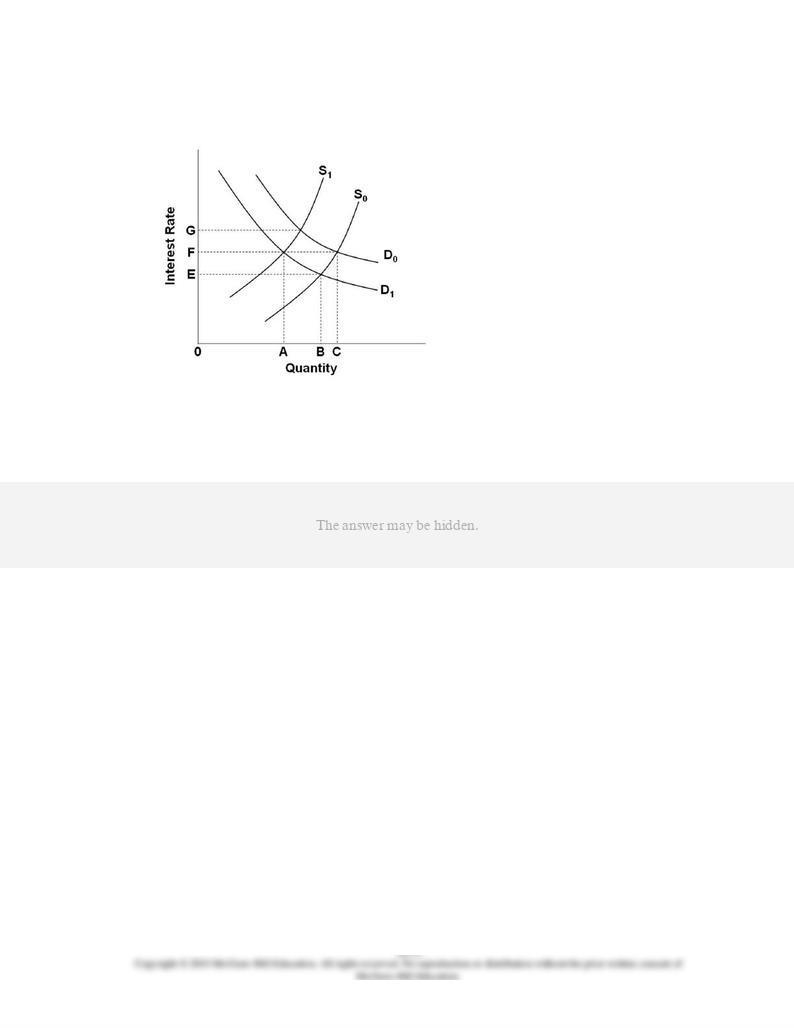
Learning Objective: 16-03 Explain the loanable funds theory of interest rates.
Topic: Loanable funds theory of interest rates
43.
Refer to the diagram. If the supply of loanable funds is
S
1 and the demand for loanable
funds is
D
1, the equilibrium interest rate and quantity of funds borrowed will be:
AACSB: Reflective Thinking
Blooms: Analyze
Difficulty: 3 Hard
Learning Objective: 16-03 Explain the loanable funds theory of interest rates.
Topic: Loanable funds theory of interest rates
Type: Graph
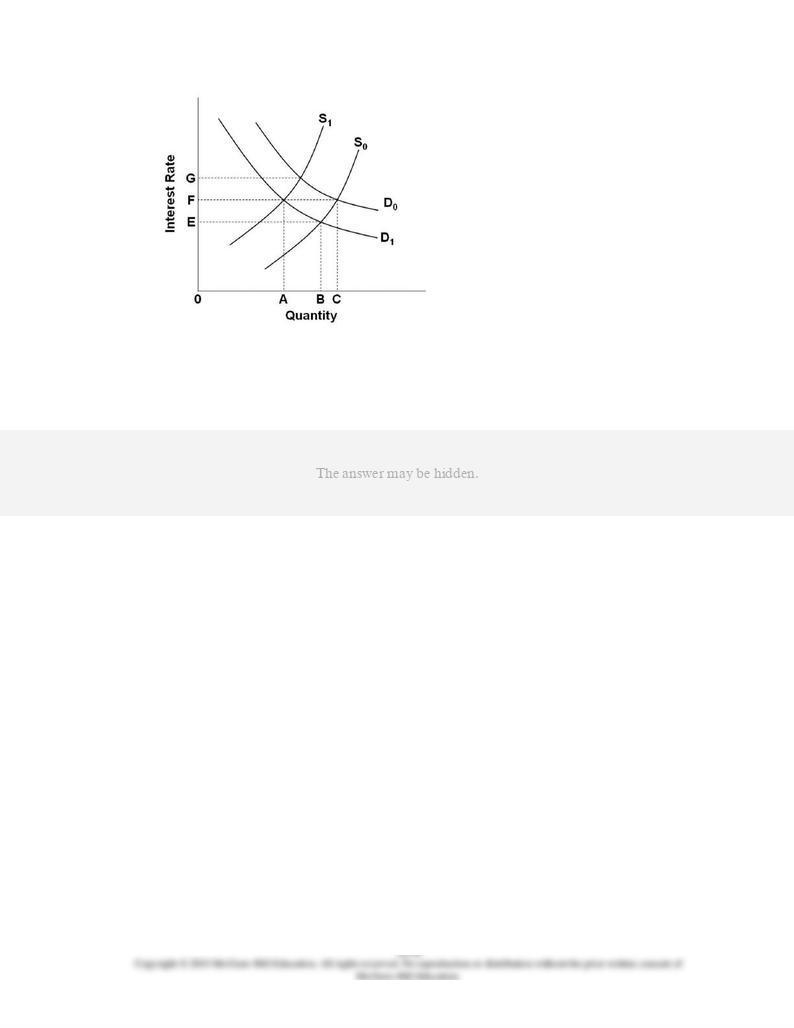
44.
Refer to the diagram. If the supply of loanable funds is
S
0 and the demand for loanable
funds is
D
0, the equilibrium interest rate and quantity of funds borrowed will be:
AACSB: Reflective Thinking
Blooms: Analyze
Difficulty: 3 Hard
Learning Objective: 16-03 Explain the loanable funds theory of interest rates.
Topic: Loanable funds theory of interest rates
Type: Graph

45.
0. If the supply of loanable funds declines to
1, the equilibrium
interest rate will:
AACSB: Reflective Thinking
Blooms: Analyze
Difficulty: 3 Hard
Learning Objective: 16-03 Explain the loanable funds theory of interest rates.
Topic: Loanable funds theory of interest rates
Type: Graph
46.
The "time-value of money" refers to the fact that:
AACSB: Analytic
Accessibility: Keyboard Navigation
Blooms: Remember

Difficulty: 1 Easy
Learning Objective: 16-04 Demonstrate how interest rates relate to the time-value of money.
Topic: Time-value of money
47.
Which of the following statements best illustrates the time-value of money concept?
AACSB: Reflective Thinking
Accessibility: Keyboard Navigation
Blooms: Apply
Difficulty: 2 Medium
Learning Objective: 16-04 Demonstrate how interest rates relate to the time-value of money.
Topic: Time-value of money
48.
On January 1, 2010, Alex deposited $5,000 into a savings account that pays interest of 5
percent, compounded annually. If he makes no further deposits or withdrawals, how much
will Alex have in his account on December 31, 2012 (3 years later)?
AACSB: Analytic
Accessibility: Keyboard Navigation
Blooms: Apply
Difficulty: 2 Medium
Learning Objective: 16-04 Demonstrate how interest rates relate to the time-value of money.
Topic: Time-value of money
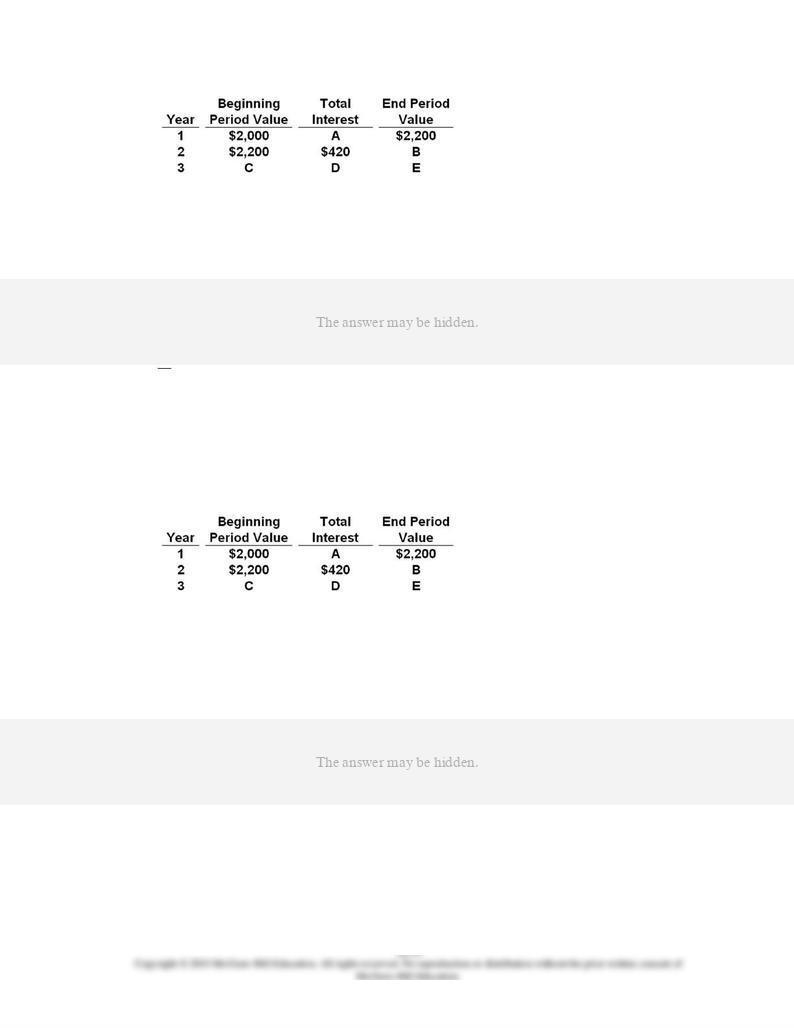
49.
Refer to the table representing Kara's bank account. Assuming that $2,000 was deposited
into her account at the beginning of year 1, the value for cell A is:
AACSB: Analytic
Blooms: Apply
Difficulty: 2 Medium
Learning Objective: 16-04 Demonstrate how interest rates relate to the time-value of money.
Topic: Time-value of money
Type: Table
50.
Refer to the table representing Kara's bank account. Assuming that $2,000 was deposited
into her account at the beginning of year 1, and no further deposits or withdrawals were
made, the value for cell B:
AACSB: Analytic
Blooms: Apply
Difficulty: 2 Medium
Learning Objective: 16-04 Demonstrate how interest rates relate to the time-value of money.
Topic: Time-value of money
Type: Table

51.
Refer to the table representing Kara's bank account. Assuming that $2,000 was deposited
into her account at the beginning of year 1, and no further deposits or withdrawals were
made, the value for cell D:
AACSB: Analytic
Blooms: Apply
Difficulty: 2 Medium
Learning Objective: 16-04 Demonstrate how interest rates relate to the time-value of money.
Topic: Time-value of money
Type: Table
52.
Refer to the table representing Kara's bank account. Assuming that $2,000 was deposited
into her account at the beginning of year 1, and no further deposits or withdrawals were
made, the value for cell E:
AACSB: Analytic
Blooms: Apply
Difficulty: 2 Medium
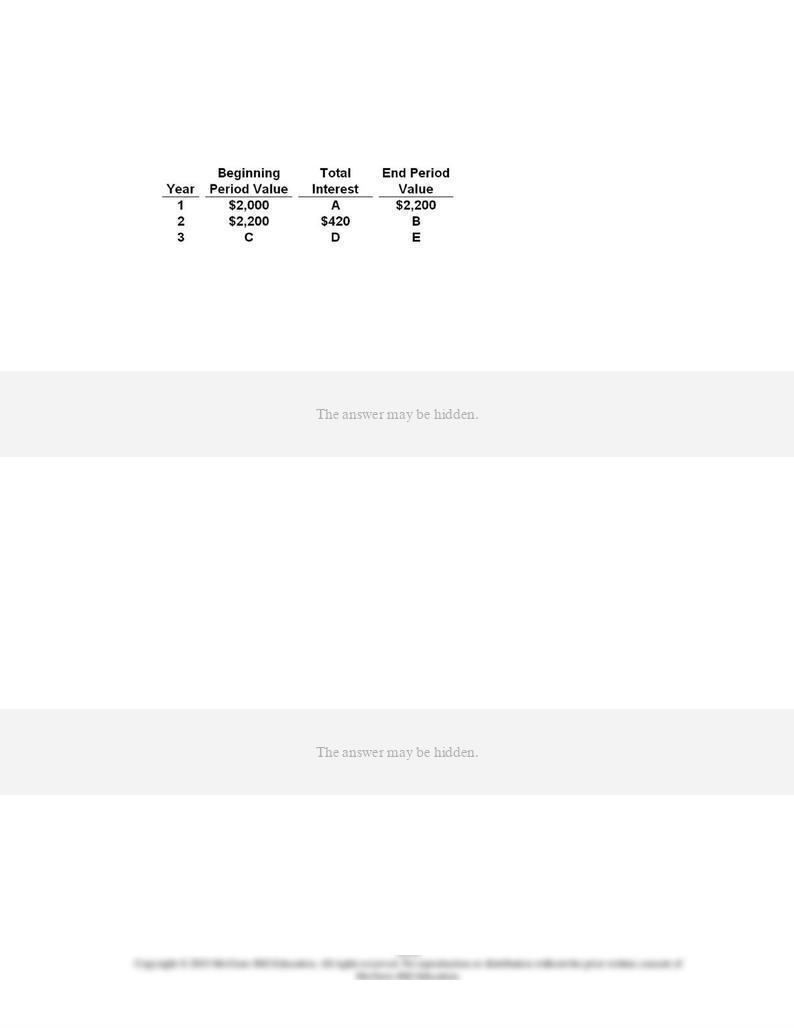
Learning Objective: 16-04 Demonstrate how interest rates relate to the time-value of money.
Topic: Time-value of money
Type: Table
53.
Refer to the table representing Kara's bank account. Assuming that $2,000 was deposited
into her account at the beginning of year 1, and no further deposits or withdrawals were
made, the interest rate Kara is receiving on her account:
AACSB: Analytic
Blooms: Apply
Difficulty: 2 Medium
Learning Objective: 16-04 Demonstrate how interest rates relate to the time-value of money.
Topic: Time-value of money
Type: Table
54.
If Kelly deposits $10,000 into an account that pays 8 percent interest, compounded
annually, and she makes no further deposits or withdrawals, how much will Kelly have in
her account at the end of 5 years?
AACSB: Analytic
Accessibility: Keyboard Navigation
Blooms: Apply
Difficulty: 2 Medium
Learning Objective: 16-04 Demonstrate how interest rates relate to the time-value of money.
Topic: Time-value of money

55.
"Present value" refers to the:
AACSB: Analytic
Accessibility: Keyboard Navigation
Blooms: Remember
Difficulty: 1 Easy
Learning Objective: 16-04 Demonstrate how interest rates relate to the time-value of money.
Topic: Time-value of money
56.
The value today of a specific sum of money to be received in the future is referred to as:
AACSB: Analytic
Accessibility: Keyboard Navigation
Blooms: Remember
Difficulty: 1 Easy
Learning Objective: 16-04 Demonstrate how interest rates relate to the time-value of money.
Topic: Time-value of money
57.
The amount to which some current amount of money will grow as interest compounds over
time is known as:
AACSB: Analytic
Accessibility: Keyboard Navigation
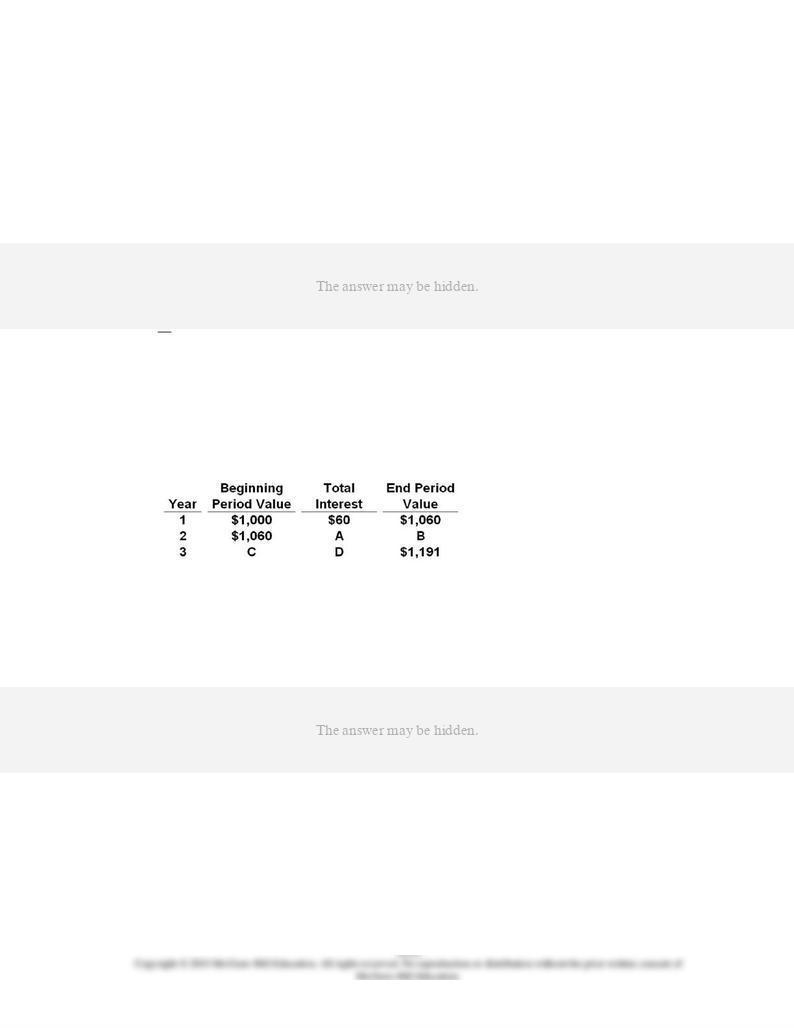
Blooms: Remember
Difficulty: 1 Easy
Learning Objective: 16-04 Demonstrate how interest rates relate to the time-value of money.
Topic: Time-value of money
58.
The "future value" of a sum of money refers to:
AACSB: Analytic
Accessibility: Keyboard Navigation
Blooms: Remember
Difficulty: 1 Easy
Learning Objective: 16-04 Demonstrate how interest rates relate to the time-value of money.
Topic: Time-value of money
59.
Refer to the table representing Darcy's bank account. Assuming that $1,000 was deposited
into her account at the beginning of year 1, and no further deposits or withdrawals were
made, how much interest would Darcy receive in Year 2 only?
AACSB: Analytic
Blooms: Apply
Difficulty: 2 Medium
Learning Objective: 16-04 Demonstrate how interest rates relate to the time-value of money.
Topic: Time-value of money
Type: Table
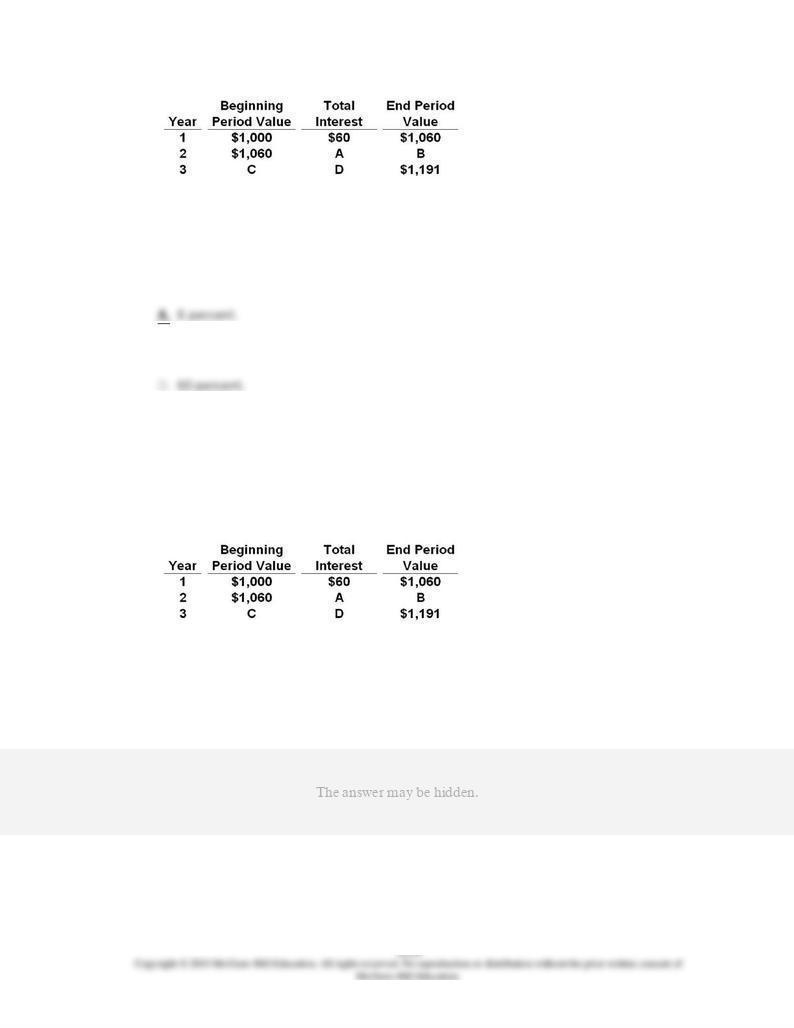
60.
Refer to the table representing Darcy's bank account. Assuming that $1,000 was deposited
into her account at the beginning of year 1, and no further deposits or withdrawals were
made, what interest rate is being paid on Darcy's account?
B.
6.4 percent.
C.
19.1 percent.
AACSB: Analytic
Blooms: Apply
Difficulty: 2 Medium
Learning Objective: 16-04 Demonstrate how interest rates relate to the time-value of money.
Topic: Time-value of money
Type: Table
61.
Refer to the table representing Darcy's bank account. Assuming that $1,000 was deposited
into her account at the beginning of year 1, and no further deposits or withdrawals were
made, the $1,191 value at the end of year 3 represents the:
AACSB: Analytic
Blooms: Apply
Difficulty: 2 Medium
Learning Objective: 16-04 Demonstrate how interest rates relate to the time-value of money.

Topic: Time-value of money
Type: Table
62.
Refer to the table representing Darcy's bank account. Assuming that $1,000 was deposited
into her account at the beginning of year 1, and no further deposits or withdrawals were
made, what is the value for cell D?
AACSB: Analytic
Blooms: Apply
Difficulty: 2 Medium
Learning Objective: 16-04 Demonstrate how interest rates relate to the time-value of money.
Topic: Time-value of money
Type: Table
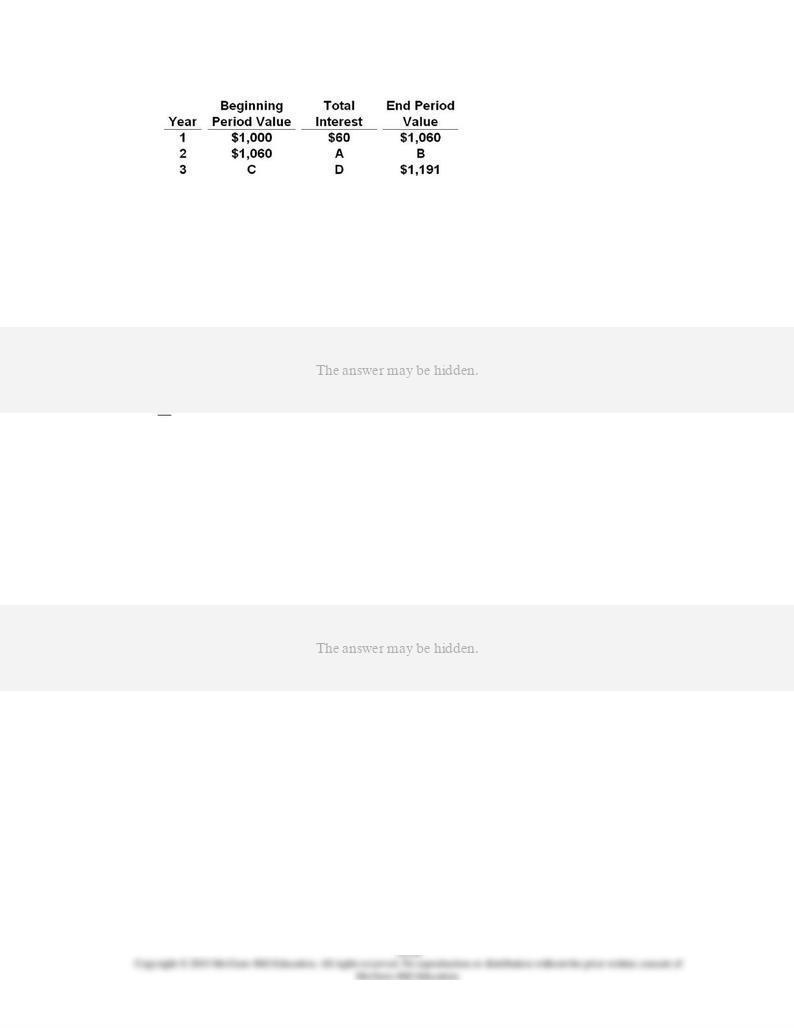
63.
Refer to the table representing Darcy's bank account. Assuming that $1,000 was deposited
into her account at the beginning of year 1, and no further deposits or withdrawals were
made, which cell(s) represents the future value of the initial deposit if the money remains
in the account for two years?
AACSB: Analytic
Blooms: Apply
Difficulty: 2 Medium
Learning Objective: 16-04 Demonstrate how interest rates relate to the time-value of money.
Topic: Time-value of money
64.
Other things equal, interest rates are:
AACSB: Reflective Thinking
Accessibility: Keyboard Navigation
Blooms: Understand
Difficulty: 2 Medium
Learning Objective: 16-05 Explain the role of interest rates in allocating capital; modulating R and D spending; and
helping to determine the economy's total output of goods and services.
Topic: Role of interest rates

65.
Which of the following generalizations is
false
? Other things equal:
AACSB: Reflective Thinking
Accessibility: Keyboard Navigation
Blooms: Understand
Difficulty: 2 Medium
Learning Objective: 16-05 Explain the role of interest rates in allocating capital; modulating R and D spending; and
helping to determine the economy's total output of goods and services.
Topic: Role of interest rates
66.
The pure rate of interest is approximated by the:
AACSB: Analytic
Accessibility: Keyboard Navigation
Blooms: Remember
Difficulty: 1 Easy
Learning Objective: 16-02 Define interest and explain how interest rates vary based on risk; maturity; loan size; and
taxability.
Topic: Interest
67.
A lower equilibrium interest rate:
AACSB: Reflective Thinking
Accessibility: Keyboard Navigation

Blooms: Understand
Difficulty: 2 Medium
Learning Objective: 16-05 Explain the role of interest rates in allocating capital; modulating R and D spending; and
helping to determine the economy's total output of goods and services.
Topic: Role of interest rates
68.
The equilibrium interest rate:
AACSB: Reflective Thinking
Accessibility: Keyboard Navigation
Blooms: Understand
Difficulty: 2 Medium
Learning Objective: 16-05 Explain the role of interest rates in allocating capital; modulating R and D spending; and
helping to determine the economy's total output of goods and services.
Topic: Role of interest rates
69.
The equilibrium interest rate:
AACSB: Reflective Thinking
Accessibility: Keyboard Navigation
Blooms: Understand
Difficulty: 2 Medium
Learning Objective: 16-05 Explain the role of interest rates in allocating capital; modulating R and D spending; and
helping to determine the economy's total output of goods and services.
Topic: Role of interest rates

70.
Other things equal, an increase in the equilibrium interest rate will:
AACSB: Reflective Thinking
Accessibility: Keyboard Navigation
Blooms: Analyze
Difficulty: 3 Hard
Learning Objective: 16-05 Explain the role of interest rates in allocating capital; modulating R and D spending; and
helping to determine the economy's total output of goods and services.
Topic: Role of interest rates
71.
Changes in the equilibrium interest rate will:
AACSB: Reflective Thinking
Accessibility: Keyboard Navigation
Blooms: Understand
Difficulty: 2 Medium
Learning Objective: 16-05 Explain the role of interest rates in allocating capital; modulating R and D spending; and
helping to determine the economy's total output of goods and services.
Topic: Role of interest rates

72.
The real rate of interest is the interest rate:
AACSB: Analytic
Accessibility: Keyboard Navigation
Blooms: Remember
Difficulty: 1 Easy
Learning Objective: 16-05 Explain the role of interest rates in allocating capital; modulating R and D spending; and
helping to determine the economy's total output of goods and services.
Topic: Role of interest rates
73.
The real interest rate can be estimated by:
AACSB: Analytic
Accessibility: Keyboard Navigation
Blooms: Remember
Difficulty: 1 Easy
Learning Objective: 16-05 Explain the role of interest rates in allocating capital; modulating R and D spending; and
helping to determine the economy's total output of goods and services.
Topic: Role of interest rates

74.
In year 1 the price level is constant and the nominal rate of interest is 6 percent. But in
year 2 the inflation rate is 3 percent. If the real rate of interest is to remain at the same
level in year 2 as it was in year 1, then in year 2 the nominal interest rate must:
AACSB: Analytic
Accessibility: Keyboard Navigation
Blooms: Apply
Difficulty: 2 Medium
Learning Objective: 16-05 Explain the role of interest rates in allocating capital; modulating R and D spending; and
helping to determine the economy's total output of goods and services.
Topic: Role of interest rates
75.
The XYZ Corporation can make a real (inflation-adjusted) return on an investment of 9
percent. The nominal rate of interest is 13 percent and the rate of inflation is 7 percent.
We can conclude that the:
AACSB: Analytic
Accessibility: Keyboard Navigation
Blooms: Analyze
Difficulty: 3 Hard
Learning Objective: 16-05 Explain the role of interest rates in allocating capital; modulating R and D spending; and
helping to determine the economy's total output of goods and services.
Topic: Role of interest rates

76.
Which of the following is
incorrect
?
AACSB: Reflective Thinking
Accessibility: Keyboard Navigation
Blooms: Understand
Difficulty: 2 Medium
Learning Objective: 16-05 Explain the role of interest rates in allocating capital; modulating R and D spending; and
helping to determine the economy's total output of goods and services.
Topic: Role of interest rates
77.
Suppose that in some year nominal interest rates are less than the rate of inflation. This
means that:
AACSB: Reflective Thinking
Accessibility: Keyboard Navigation
Blooms: Understand
Difficulty: 2 Medium
Learning Objective: 16-05 Explain the role of interest rates in allocating capital; modulating R and D spending; and
helping to determine the economy's total output of goods and services.
Topic: Role of interest rates

78.
In making an investment decision, a business firm is most interested in the:
AACSB: Reflective Thinking
Accessibility: Keyboard Navigation
Blooms: Understand
Difficulty: 2 Medium
Learning Objective: 16-05 Explain the role of interest rates in allocating capital; modulating R and D spending; and
helping to determine the economy's total output of goods and services.
Topic: Role of interest rates
79.
Effective usury laws cause:
AACSB: Reflective Thinking
Accessibility: Keyboard Navigation
Blooms: Understand
Difficulty: 2 Medium
Learning Objective: 16-05 Explain the role of interest rates in allocating capital; modulating R and D spending; and
helping to determine the economy's total output of goods and services.
Topic: Role of interest rates
80.
Usury laws:
AACSB: Analytic

Accessibility: Keyboard Navigation
Blooms: Remember
Difficulty: 1 Easy
Learning Objective: 16-05 Explain the role of interest rates in allocating capital; modulating R and D spending; and
helping to determine the economy's total output of goods and services.
Topic: Role of interest rates
81.
Effective usury laws cause:
AACSB: Reflective Thinking
Accessibility: Keyboard Navigation
Blooms: Understand
Difficulty: 2 Medium
Learning Objective: 16-05 Explain the role of interest rates in allocating capital; modulating R and D spending; and
helping to determine the economy's total output of goods and services.
Topic: Role of interest rates
82.
Effective usury laws:
AACSB: Reflective Thinking
Accessibility: Keyboard Navigation
Blooms: Understand
Difficulty: 2 Medium
Learning Objective: 16-05 Explain the role of interest rates in allocating capital; modulating R and D spending; and
helping to determine the economy's total output of goods and services.
Topic: Role of interest rates

83.
A major purpose of usury laws is to make more funds available to low-income borrowers.
Economic analysis suggests that usury laws:
AACSB: Reflective Thinking
Accessibility: Keyboard Navigation
Blooms: Understand
Difficulty: 2 Medium
Learning Objective: 16-05 Explain the role of interest rates in allocating capital; modulating R and D spending; and
helping to determine the economy's total output of goods and services.
Topic: Role of interest rates
84.
Economic profit is most closely associated with:
AACSB: Reflective Thinking
Accessibility: Keyboard Navigation
Blooms: Understand
Difficulty: 2 Medium
Learning Objective: 16-06 Relate why economic profits occur; and how profits; along with losses; allocate resources
among alternative uses.
Topic: Economic profit

85.
Which of the following represents an uninsurable risk to a business firm?
AACSB: Reflective Thinking
Accessibility: Keyboard Navigation
Blooms: Apply
Difficulty: 2 Medium
Learning Objective: 16-06 Relate why economic profits occur; and how profits; along with losses; allocate resources
among alternative uses.
Topic: Economic profit
86.
Economic profit might result from:
AACSB: Reflective Thinking
Accessibility: Keyboard Navigation
Blooms: Understand
Difficulty: 2 Medium
Learning Objective: 16-06 Relate why economic profits occur; and how profits; along with losses; allocate resources
among alternative uses.
Topic: Economic profit

87.
A normal profit is:
AACSB: Analytic
Accessibility: Keyboard Navigation
Blooms: Remember
Difficulty: 1 Easy
Learning Objective: 16-06 Relate why economic profits occur; and how profits; along with losses; allocate resources
among alternative uses.
Topic: Economic profit
88.
Pure or economic profit is:
AACSB: Analytic
Accessibility: Keyboard Navigation
Blooms: Remember
Difficulty: 1 Easy
Learning Objective: 16-06 Relate why economic profits occur; and how profits; along with losses; allocate resources
among alternative uses.
Topic: Economic profit

89.
Economic profit affects:
AACSB: Reflective Thinking
Accessibility: Keyboard Navigation
Blooms: Understand
Difficulty: 2 Medium
Learning Objective: 16-06 Relate why economic profits occur; and how profits; along with losses; allocate resources
among alternative uses.
Topic: Economic profit
90.
The largest single share of all income earned by Americans consists of:
AACSB: Reflective Thinking
Accessibility: Keyboard Navigation
Blooms: Remember
Difficulty: 1 Easy
Learning Objective: 16-07 List the share of U.S. earnings received by each of the factors of production.
Topic: Income shares
91.
Currently capitalist income, that is, corporate profits, interest, and rent, accounts for about
what percentage of the income paid to American resource suppliers?
AACSB: Reflective Thinking
Accessibility: Keyboard Navigation

Blooms: Remember
Difficulty: 1 Easy
Learning Objective: 16-07 List the share of U.S. earnings received by each of the factors of production.
Topic: Income shares
92.
If labor's share of the income paid to American resource suppliers is broadly defined as
the sum of wages and salaries and proprietors' income, we can say that labor's relative
share has:
AACSB: Reflective Thinking
Accessibility: Keyboard Navigation
Blooms: Remember
Difficulty: 1 Easy
Learning Objective: 16-07 List the share of U.S. earnings received by each of the factors of production.
Topic: Income shares
93.
Capitalist income (corporate profits, interest, and rent) has:
AACSB: Reflective Thinking
Accessibility: Keyboard Navigation
Blooms: Remember
Difficulty: 1 Easy
Learning Objective: 16-07 List the share of U.S. earnings received by each of the factors of production.
Topic: Income shares

94.
Defined narrowly as wages and salaries, labor's share of the national income is about:
AACSB: Reflective Thinking
Accessibility: Keyboard Navigation
Blooms: Remember
Difficulty: 1 Easy
Learning Objective: 16-07 List the share of U.S. earnings received by each of the factors of production.
Topic: Income shares
95.
(Consider This) The story about economist Irving Fisher's conversation with his masseuse
illustrates that:
AACSB: Reflective Thinking
Accessibility: Keyboard Navigation
Blooms: Apply
Difficulty: 2 Medium
Learning Objective: 16-04 Demonstrate how interest rates relate to the time-value of money.
Topic: Time-value of money

96.
(Consider This) The story about economist Irving Fisher's conversation with his masseuse
illustrates that interest payments arise because of:
AACSB: Reflective Thinking
Accessibility: Keyboard Navigation
Blooms: Apply
Difficulty: 2 Medium
Learning Objective: 16-04 Demonstrate how interest rates relate to the time-value of money.
Topic: Time-value of money
97.
(Last Word) Suppose you borrow $500 and agree to pay this $500 plus $75 of interest at
the end of a year. The interest rate is:
C.
12.5 percent.
D.
7.5 percent.
AACSB: Analytic
Accessibility: Keyboard Navigation
Blooms: Apply
Difficulty: 2 Medium
Learning Objective: 16-02 Define interest and explain how interest rates vary based on risk; maturity; loan size; and
taxability.
Topic: Interest

98.
(Last Word) Suppose you borrow $500 for a year and the lender discounts $75 of interest
at the time the loan is made (giving the borrower only $425). The interest rate on this loan
A.
12.5 percent.
B.
14.5 percent.
C.
17.6 percent.
AACSB: Analytic
Accessibility: Keyboard Navigation
Blooms: Apply
Difficulty: 2 Medium
Learning Objective: 16-02 Define interest and explain how interest rates vary based on risk; maturity; loan size; and
taxability.
Topic: Interest
99.
(Last Word) Suppose you deposit $5,000 in a bank that pays 10 percent interest
compounded twice a year. The actual annual interest rate you receive is:
C.
10.25 percent.
AACSB: Analytic
Accessibility: Keyboard Navigation
Blooms: Apply
Difficulty: 2 Medium
Learning Objective: 16-02 Define interest and explain how interest rates vary based on risk; maturity; loan size; and
taxability.
Topic: Interest
True / False Questions

100.
Demand is the active and supply the passive determinant of land rent.
AACSB: Reflective Thinking
Accessibility: Keyboard Navigation
Blooms: Understand
Difficulty: 2 Medium
Learning Objective: 16-01 Explain the nature of economic rent and how it is determined.
Topic: Economic rent
101.
Different rents on land reflect differences in the marginal revenue product of land.
AACSB: Reflective Thinking
Accessibility: Keyboard Navigation
Blooms: Understand
Difficulty: 2 Medium
Learning Objective: 16-01 Explain the nature of economic rent and how it is determined.
Topic: Economic rent
102.
The free-land era of U.S. history reflected a situation in which the quantity of land
available at a zero price exceeded the quantity of land demanded.
AACSB: Reflective Thinking
Accessibility: Keyboard Navigation
Blooms: Understand
Difficulty: 2 Medium
Learning Objective: 16-01 Explain the nature of economic rent and how it is determined.
Topic: Economic rent
103.
Rent performs an incentive function, but no rationing function.
AACSB: Reflective Thinking
Accessibility: Keyboard Navigation
Blooms: Understand
Difficulty: 2 Medium
Learning Objective: 16-01 Explain the nature of economic rent and how it is determined.
Topic: Economic rent: land taxation

104.
The interest rate is the price paid for the use of money.
AACSB: Analytic
Accessibility: Keyboard Navigation
Blooms: Remember
Difficulty: 1 Easy
Learning Objective: 16-02 Define interest and explain how interest rates vary based on risk; maturity; loan size; and
taxability.
Topic: Interest
105.
Unlike most demand curves, the demand curve for loanable funds is upsloping.
AACSB: Reflective Thinking
Accessibility: Keyboard Navigation
Blooms: Understand
Difficulty: 2 Medium
Learning Objective: 16-03 Explain the loanable funds theory of interest rates.
Topic: Loanable funds theory of interest rates
106.
Present value is the amount to which some current amount of money will grow as interest
compounds over time.
AACSB: Analytic
Accessibility: Keyboard Navigation
Blooms: Remember
Difficulty: 1 Easy
Learning Objective: 16-04 Demonstrate how interest rates relate to the time-value of money.
Topic: Time-value of money
107.
The time-value of money refers to the idea that a given amount of money is more valuable
to a person the sooner it is received.
AACSB: Analytic
Accessibility: Keyboard Navigation
Blooms: Remember

Difficulty: 1 Easy
Learning Objective: 16-04 Demonstrate how interest rates relate to the time-value of money.
Topic: Time-value of money
108.
The future value of $3,000 deposited today at 5 percent interest is $3,646.52 four years
from now.
AACSB: Analytic
Accessibility: Keyboard Navigation
Blooms: Apply
Difficulty: 2 Medium
Learning Objective: 16-04 Demonstrate how interest rates relate to the time-value of money.
Topic: Time-value of money
109.
The present value of $4,000 deposited today at 8 percent interest is $5,038.85 three years
from now.
AACSB: Analytic
Accessibility: Keyboard Navigation
Blooms: Apply
Difficulty: 2 Medium
Learning Objective: 16-04 Demonstrate how interest rates relate to the time-value of money.
Topic: Time-value of money
110.
Other things equal, the shorter the loan period and the larger the loan size, the higher is
the interest rate charged by the lender.
AACSB: Reflective Thinking
Accessibility: Keyboard Navigation
Blooms: Understand
Difficulty: 2 Medium
Learning Objective: 16-04 Demonstrate how interest rates relate to the time-value of money.
Topic: Time-value of money

111.
The supply of loanable funds is perfectly elastic.
AACSB: Reflective Thinking
Accessibility: Keyboard Navigation
Blooms: Understand
Difficulty: 2 Medium
Learning Objective: 16-03 Explain the loanable funds theory of interest rates.
Topic: Loanable funds theory of interest rates
112.
Economic profits are the salaries received by the hired managers of business
corporations.
AACSB: Analytic
Accessibility: Keyboard Navigation
Blooms: Remember
Difficulty: 1 Easy
Learning Objective: 16-06 Relate why economic profits occur; and how profits; along with losses; allocate resources
among alternative uses.
Topic: Economic profit
113.
The basic function of profits and losses is to allocate society's scarce resources to their
highest valued uses.
AACSB: Reflective Thinking
Accessibility: Keyboard Navigation
Blooms: Understand
Difficulty: 2 Medium
Learning Objective: 16-06 Relate why economic profits occur; and how profits; along with losses; allocate resources
among alternative uses.
Topic: Economic profit
114.
Broadly defined, labor's share of national income has been remarkably stable since 1900.
AACSB: Reflective Thinking
Accessibility: Keyboard Navigation
Blooms: Remember

Difficulty: 1 Easy
Learning Objective: 16-07 List the share of U.S. earnings received by each of the factors of production.
Topic: Income shares